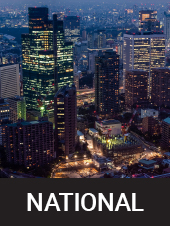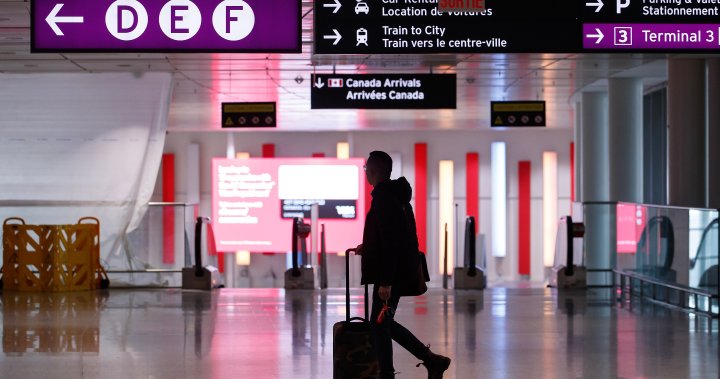As many Canadians cancel their trips to the U.S. amid the trade war and annexation threats, costs to travel within the Great White North remains high — but there’s a lot more than just your seat on the plane that goes into the price.
The trade war and U.S. President Donald Trump’s threats to turn Canada into the 51st state have spurred a surge in “Buy Canadian” sentiment, including calls from federal leaders for Canadians to axe travel plans to the U.S. and vacation in the country instead.
But when Canadians purchase their tickets, they may notice additional costs beyond their seat on the plane and baggage fee.
“The airlines have basically compounded the problem and kind of lumped a whole bunch of other things on top of the normal stuff we pay,” said John Gradek, an aviation management professor at McGill University.
When you buy your ticket, the first cost you’ll face is your base fare, the initial cost of the airline ticket excluding additional fees, taxes or surcharges and directly represents the price of the seat itself.
While there are fees you might face, such as your seat cost, carry-on or checked luggage and food on the plane, there are non-optional fees you’ll be charged when you buy your ticket.
On top of the actual base fare, most airlines add on various surcharges, the GST or HST, an Air Travellers Security Charge, an Airport Improvement Fee and a NAV (Canada) fee.
But what exactly are these fees?
The government sales tax (GST) or harmonized sales tax (HST) is standard in nearly everything people buy, but the Air Travellers Security Charge is not unless you’re buying an airline ticket.
The charge is implemented by the federal government and used to fund security personnel for airport screening by the Canadian Air Transport Security Authority.

Get breaking National news
For news impacting Canada and around the world, sign up for breaking news alerts delivered directly to you when they happen.
The fee is typically implemented on every flight, whether a round trip or single flight, but according to the Canada Revenue Agency, every flight in Canada faces a charge of $9.46, up to a maximum of $18.92.
The CRA notes there are some exemptions when you won’t face the security fee, which is laid out on its website.
The NAV Canada fee is another cost built in, as the company — which provides services including air traffic control, weather briefings and airport advisory services — does not receive government funding.
As a result, the cost is charged to airlines who then charge customers to recover the cost.
Travellers may also notice surcharges on the ticket price, which often encompasses various costs for the airline.
According to Air Canada, the surcharges it asks customers to pay are used to offset some costs, including fuel, navigational and insurance charges, as well as if someone is flying at a peak travel date.
Porter has similar costs, noting the changing costs of fuel can also adjust the surcharge.

One of the other fees you might notice is an airport improvement fee, something charged by airports themselves to use for capital projects, maintenance and expansion.
The cost typically varies from airport to airport, with some like Toronto Pearson International Airport charging departing customers $37 plus taxes and connecting travellers $7.
Calgary International, on the other hand, charges $35 per passenger on all flights departing from the city.
But while these fees are built in, some question the need for some costs like security, arguing the government should absorb the cost.
“Policing is a pure public good,” said Ian Lee, an associate professor at the Sprott School of Business at Carleton University.
“We don’t get charged back for the RCMP, we don’t get charged back for CBSA (Canada Border Services Agency), so the government will absorb that. It’s part of national security and we’re not going to pass that on to the consumer.”
How does that all break down?
As an example of what you might see, let’s take a look at a traveller departing from Toronto for Halifax on June 9, returning June 11, on Air Canada compared to Porter Airlines for similar flight times.
On Porter Airlines’ standard fare, one adult would see on their departing flight a cost of $260 for their base fare with NAV fee and surcharges of approximately $30 as part of the air transportation charges.
They would then be charged $9.46 for the security fee, $37 for improvement fee and $43.74 for HST.
On their return flight, there would be no NAV fee, but they would face the same security fee as well as $35 for airport improvement and $25.76 in tax.
Air Canada combines the majority of its fees, with the departing base fare at $207.81 and $190 for its return. It then charges $30 in carrier surcharges, $18.92 in security fees, $72 in airport improvement, and $67.78 in tax.
With the federal election underway, Lee said it’s yet to be seen how the parties will potentially tackle airline fees, something not touched yet in campaign announcements by any of the party leaders.
However, he’d encourage the winning party to address how fees are charged at a time when Canadians are struggling with affordability, with many trying to ‘Buy Canadian’ — including their trips.
Gradek adds that when you do book, know that you’re buying more than the seat.
“You’ve got to be really cautious of what you’re buying, understand the conditions, understand the restrictions that the airlines are putting on you as you buy different levels of tickets on a given route,” Gradek said. “So it’s getting kind of messy that the actual seat price might be relatively low, but after you finish paying for all of the goodies and all the taxes and all the charges, it could add up pretty quickly.”






